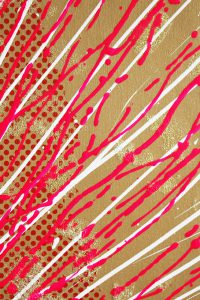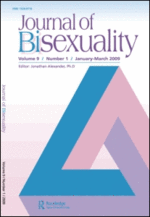BiReCon Proceedings: A forthcoming issue of The Journal of Bisexuality
6 of 9: Bisexuality, Gaia, Eros: Portals to the Arts of Loving
Part 2 – Addressing the Audience: Bisexuality and Ecology Today
BiReCon Proceedings: A forthcoming issue of The Journal of Bisexuality
4 of 9: Bisexuality, Gaia, Eros: Portals to the Arts of Loving – Preview
“Bisexuality, Gaia, Eros: Portals to the Arts of Loving”
BiReCon Proceedings: A forthcoming issue of The Journal of Bisexuality
3 of 9: Bisexuality, Gaia, Eros: Portals to the Arts of Loving – Preview
BiReCon | 28 BiCon | 10 ICB
BiReCon Proceedings: A forthcoming issue of The Journal of Bisexuality
2 of 9: Bisexuality, Gaia, Eros: Portals to the Arts of Loving
So the idea of a portal seemed fine. It would open new horizons. It would resonate with the work of Robyn Ochs, another keynote speaker, whose book, Getting Bi, registers voices of bi people across the planet. Yet it felt a bit off and perhaps not quite in tune with what was out there in the melee of early third-millennium bisexual life. After all, I came out in the early 1990s, I’ve organized my personal and professional life largely around bisexuality, and I’ve had plenty of time to select extraneous influxes out of it. Attendance in BiReCon and BiCon combined provided a unique standpoint to get the pulse of where bisexuality is at in a variety of geo-cultural locations and from the multiple perspectives of research, scholarship, theory, creative expression, advocacy, and community building. (For insights on those dynamics I refer readers to “BiReCon,” in this volume, a contribution by the organizers.) The context was perfect for producing knowledge in action. At the time of this writing, I’ve had a chance to reflect on my own keynote remarks, on the experience of participating in the two events combined, and the process of creating the present volume from contributions thereof. I choose this as an opportunity to offer the wisdom of what I learned in the process, along with a written elaboration of my keynote remarks.
BiReCon Proceedings: A forthcoming issue of The Journal of Bisexuality
1 of 9: Bisexuality, Gaia, Eros: Portals to the Arts of Loving
Acknowledgement: This piece is pre-published here with permission of Routledge, New York, a division of Taylor and Francis.
BiReCon Proceedings: A forthcoming issue of The Journal of Bisexuality
Polyamour | Toward a New Sexual Love Ethic – by Tinamarie Bernard
It is so great to hear Tinamarie Bernard, a muse of love in modern times, be moved by Deborah Taj Anapol to think of her own self as polyamorous. Yes, Tinamarie, we all have something to learn from Taj’s wisdom.
“Polyamour | Toward a New Sexual Love Ethic”
A review of Polyamory in the 21st Century by Tinamarie Bernard
3WayKisses from Gaia – Will the Chrisalys Turn into a Butterfly Soon? Reflections & Season’s Greetings
Hi lovely Earthlings!
Gaia sends 3WayKisses and warm wishes to all of you. Happy Solstice, Eclipse, Holidays, and 2011!
We are amazed at the forces acting on the transformation of the third planet. Will the chrysalis turn into a butterfly soon? Many feel that today’s coincidence of solstice and Lunar eclipse begins the paradigm shift. Watch it tonight at 2:40AM EST! The current crisis could be just an opportunity for opposites to meet. Eros and Gaia, matter and energy, the Earth and the sky, water and fire, sex and love, humans and nature, the Sun and the Moon: aren’t these just mental energy fields that come together in a sensual communion the minute we accept the interconnectedness of all being? More at Gemini Astrology, Hawaii
 |
| This Means Everything to Me 5 – Toby Mott |
The power of knowledge keeps moving yours truly. At this time the very existence of the institution that has sustained her for the past 13 years is in question. The University of Puerto Rico is under siege by a new governor who wants to sell it to those who fund his career. Yet yours truly has never been as excited to be in class as this year. With students’ awareness enhanced by the strike last spring, teaching has become more in-the-moment, more real! Their appetite for knowledge makes up for all difficulties. Now it’s time for professors to be in action about the accreditation of the institution. Rallies, meetings, negotiating solutions, reviving organizations are our daily activities. You can get a peak from our videos. The situation has resonated across regions. Many US-based scholars originally from Puerto Rico have pitched in. Their letter to the Attorney General is moving. It bears seventy-four signatures! Full text here! UPR is not alone. May this be the tip of a tidal wave that honors the desire for knowledge honest people harbor within.
Winter Solstice is a special time for hostess Gaia. She remembers the Saturnalia, a festival of joy and abundance that celebrated the Reign of Saturn in ancient Rome at this time of year. In the age of Titans, when the forces of nature reigned supreme, Gaia, the earth, and her lover Uranus, the sky, conceived Saturn, the state of being sated, abundant He presided over the happiest age in the life of our species. This Golden Age was known as Saturnia Regna in Antiquity. It was a time when pleasure was an ally of nature and sexual abundance was revered. Gaia would like to see us revel as did our pagan ancestors this time of year. Join yous truly in wishing the third planet a joyful holiday season. When you prepare your gifts, make sure they align with your most authentic beliefs. Want a new age of love? We provide the politics–the practice is up to you! This is the best time for 3WayKisses! You can donate here!
At the October ecosexual gathering in LA, yours truly’s latest opus found its true crowd. Ecosexuality is in! On the 23 and 24 of that momentous month, it was amazing to feel the vibration of this new style of love where pleasure and nature marry each other. The occasion was the 3WayWedding of a highly Saturnian couple, ecosexual artists Annie Sprinkle and Beth Stephens, and Gaia’s favorite satellite, the Moon. Befitting HoneyMoon was the world’s first Symposium on Ecosexuality. The brides shared wisdom with a crowd of imaginative Earthlings gathered for this momentum meeting. Is nature an enemy, a mother, a lover? Imagining the Earth as a lover can bring lots of fun into the global ecology movement. But Gaia is a hostess too! Shall we learn to respect her before we begin to woo her? Yours truly was invited to deliver a Message from Gaia. She gave the Symposium’s Opening Remarks too! Her featured book, Gaia, resonated with authentic meaning in the neighborhood of this inspiring group. The quest for the meaning of ecosexuality is open and many voices are pitching in. The movement swarms with the Saturnian energies of the season.
 |
| This Means Everything to Me 5 – Detail |
Gaia also attracted a whole bunch of new readers. The big push-up back in September helped a great deal. Thanks to all who pitched in! Around the 26th, sales ranks rose into the 11,000 for general Kindle, 85,000 for paperback list. They stayed there for quite a while. Not stunning yet encouraging. The title rose much higher in specialized lists: Up to top 4th in Feminist Theory, next to Betty Friedan, Mary Wollstonecraft, Judith Butler, and Naomi Wolf. What a delightful City of Ladies. How very exciting to be admitted! Most astounding of all, the title rose to top 1 for the Mind/Body, Diseases, Aids list. It’s still there, top 31st. Yours truly is honored to be part of this group. Good scientists pursue the truth even when they don’t like it. Poor scientists are afraid of controversial issues. Unbiased perspectives should be available to people who are able to make their own responsible choices. When it comes to knowledge, the true enemy is fear. Look at what’s happening with Wikileaks! If you’ve liked the book, you can vote for it in Goodreads. Check the Choice Awards and the Books on Love lists. There’s a whole range of good reads from yours truly. Look up her author’s page here! We wish we could share actual sales figures with you. Unfortunately, the digital giant Amazon.com won’t even disclose them to yours truly!
 “What about teaching?” you may ask. Yes, we are doing it, with a Course in Ecosexuality starting at UPR Mayaguez in January. Find out how to enroll here! We also got a sense of how interested people are in what we have to teach from the social media, as in Facebook. Polyamory is big hit! And we see it as part of the arts of conscious loving. So we are looking for a hospitable facility in Italy. If you’re aware of one, please let us know soon! We have a fantastic team: Yours truly, whose talk about polyamory has been a highlight of Italian TV; and Robert Silber, from Hawaii, who specializes in conscious sensuality, communication and community. We are putting together the first bilingual course on the arts of conscious loving, with simultaneous translation on the floor as we teach! We plan to teach it in July and will announce the location as soon as we have one for sure. English, with its scientific specificity; and Italian, with its passion and romance. Stay tuned for specific time and place for this groundbreaking experience!
“What about teaching?” you may ask. Yes, we are doing it, with a Course in Ecosexuality starting at UPR Mayaguez in January. Find out how to enroll here! We also got a sense of how interested people are in what we have to teach from the social media, as in Facebook. Polyamory is big hit! And we see it as part of the arts of conscious loving. So we are looking for a hospitable facility in Italy. If you’re aware of one, please let us know soon! We have a fantastic team: Yours truly, whose talk about polyamory has been a highlight of Italian TV; and Robert Silber, from Hawaii, who specializes in conscious sensuality, communication and community. We are putting together the first bilingual course on the arts of conscious loving, with simultaneous translation on the floor as we teach! We plan to teach it in July and will announce the location as soon as we have one for sure. English, with its scientific specificity; and Italian, with its passion and romance. Stay tuned for specific time and place for this groundbreaking experience!
 On this note, we wish a joyful holiday to the entire planet and all of you. The climate change summit in Cancun has not yielded great results. But we at 3WayKiss have solutions. The new politics of love we propose is ecological and sexy too. Vive ecosexuality! Stop third planet abuse! As a new year resolution, can we pledge to practice love and respect for our lovely hostess? Let’s hope Gaia finds more patience within. Meanwhile, thanks to Toby Mott for his inspiring paintings. Check him out here!
On this note, we wish a joyful holiday to the entire planet and all of you. The climate change summit in Cancun has not yielded great results. But we at 3WayKiss have solutions. The new politics of love we propose is ecological and sexy too. Vive ecosexuality! Stop third planet abuse! As a new year resolution, can we pledge to practice love and respect for our lovely hostess? Let’s hope Gaia finds more patience within. Meanwhile, thanks to Toby Mott for his inspiring paintings. Check him out here!
Namaste,
Serena Anderlini-D’Onofrio, PhD
University of Puerto Rico, Mayaguez
Gaia Mother, Hostess, Lover – Keynote – World’s First Ecosexuality Symposium
And finally, the HoneyMoon starts. The brides, now wedded to Gaia’s satellite, invited all of us to share their sacred nuptial time.
Listen to yours truly’s keynote opening remarks:
Notes from the Symposium’s Opening Remarks
“Evil nature: the kind of thinking typical of western mentality, where we want control, and that gets us to global warming. We’re so afraid to let go of our anxiety that we end us causing our own doom and Gaia kicks us out!
Nature as Mother: this is nice, typical of environmentalist culture, nature is a good old woman, we must ‘save’ her, oh well . . .
Earth as ‘lover,’ says Annie Sprinkle, makes ecology sound like fun!
I like to come back to the concept of Gaia, which lives as myth, science, and part of vernacular culture.
It refers to the web of life on the third planet: biosphere, atmosphere, and, I would like to add, noosphere, or the sphere of the interconnected mental/emotional energies of all those who are alive.
What I’d like to propose is that we imagine Gaia as hostess, with us humans as guests among others.
Hostess as mother: we live inside, it’s cozy, and at one point we get kicked
out.
Hostess as lover: someone who welcomes us in their lives, who holds the
space of love for us, who acts as a resource of love for us.
Hosts and guests are ecosystems, they are symbiotic with one another, they exchange
energies and rebalance, they respect each other’s balance, they enhance it, they must not deplete each other too much.
Ecosystemic balance is what we want in our practices of ecosexual love.
These are practices of love that respect, enhance the balance, the vitality of our personal ecosystem and our lovers’s, and our lovers’s lovers, and so on and so forth around the planet.
These are practices of holistic sexual health that enhance the tantric force field across the body of Gaia and activate the material with the sacred energy of love, or Eros as the ancients called it.
The biosphere, the atmosphere, the noosphere become resacralized with this erotic energy of love, the chakra system of each person becomes aligned and the whole body of Gaia becomes integrated and balanced.
In ecosex we are resources of love for each other and we multiply the connectedness among all of us so that we become more respectful guests to our hostess, we become more loving and considerate of her.
How does the noosphere enter the picture, one might ask? Cyberspace is an actualization of the sphere of the mind, it is telepathy on wi-fi. Cyberspace is also a space of the imagination where the very concepts of sex, love, faithfulness, romance, eroticism are being redefined, it is a new space where the emotions travel.
When we become more cognizant of how the sacred (eco) and the material (sex) are one, of how matter and energy are aligned, the noosphere becomes more integrated and active, more creative and imaginative, so that solutions to the current ecosystemic crisis are found.”
And on this hopeful note, yours truly ended her remarks. Many subsequent talks, acts, performances, dances followed. What creativeness! What abundance!
At the end, many participants were inspired to get their own copy of Gaia. This book had finally found its public. Woooooow! Yours truly really felt that all the flack, the adverse reaction, the struggles of last year were rewarded. She felt really proud of her effort and appreciated for her gifts to the world and humanity.
Now that you are preparing to choose your Solstice/Holiday Season gifts, don’t forget to pick one that helps humanity make peace with the third planet. Where would we all be without her hospitality? How would we desire, meet, fall in love with each other? She provides the space for us to thrive and deserves to be treated with reverence and awe. Let’s begin now!
For a list of works where you can begin your education in Ecosexuality, go to the author’s page now! You can download Gaia on Kindle and start reading in the next five minutes! Don’t waste more time!
Wishing a joyful Solstice, and Christmas, and New Year to each and everyone!
Namaste ((-:~
Your VOTE for GAIA!
Hi lovely Earthlings!
I’ve discovered GOODREADS, courtesy of ever savvy Reid Mihalko. And I’ve created a profile, an account, and a book shelf. Don’t you want to find out what’s on it?
GOODREADS also invites votes on best books for 2010. Gaia on Kindle qualifies! Time is almost up! To vote for Gaia and the New Politics of Love, click on the link and insert your title in the write-in option.
http://www.goodreads.com/award/choice#41646-Nonfiction
Gaia thanks you! It’s nice for your hostess to feel so very deeply appreciated!








